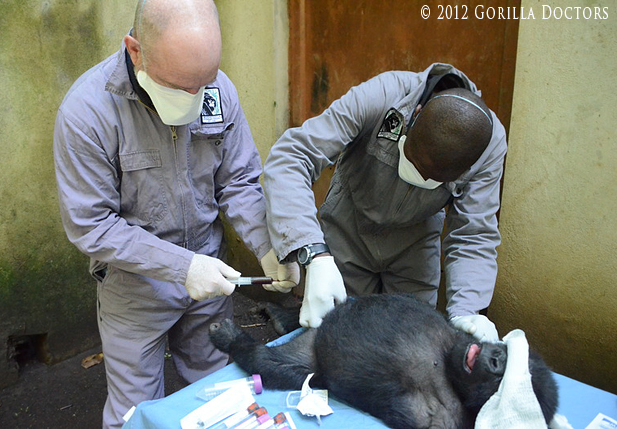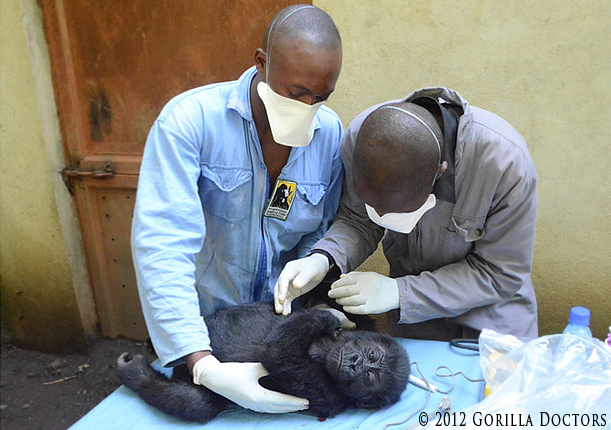Final Quarantine Exams Completed for New Orphans
By Gorilla Doctors Staff on Thursday, December 20th, 2012 in Blog, Uncategorized.After three months in quarantine at the Senkwekwe Center in Rumangabo, DRC, orphaned Grauer’s gorillas Baraka and Isangi received their final quarantine exams this week- the final step before clearance is granted for the infants to move to their long-term home.
Isangi
Ten-month-old baby Isangi is bright, strong, active and healthy after three months in quarantine. During her exam, fecal samples were collected for genetic studies. The results of her genetic analysis will confirm her subspecies as Grauer’s, and thus determine her long term destination. Blood samples were collected for hematology and biochemistry testing and all results are within normal limits, suggesting that Isangi is in good health.
 Infant Isangi is examined by Drs. Mike and Eddy at the Senkwekwe Center in DRC.
Infant Isangi is examined by Drs. Mike and Eddy at the Senkwekwe Center in DRC.
Baraka
Baraka’s first quarantine exam revealed that the infant was anemic. Her condition was thought to be due to an iron deficiency and malnutrition. She was given an oral iron supplement every day for three months. Her appetite and diet have improved since and she is now drinking a more concentrated milk formula. During her second full exam, her blood test showed an improvement in her hematocrit/packed cell volume: from 22% up to 40%. On the 3rd and final quarantine examination, her hematocrit was again at a normal 40% and we considered the iron deficiency to be resolved and discontinued the iron supplement.
On October 28, Baraka’s caretaker Janvier reported that she had developed diarrhea. We suspected it to be infectious and the decision was made to put her on an antibiotic and antiprotozoal (c iprofloxacin and metronidazole). In addition, Baraka was given a probiotic supplement and fluid therapy. Her diarrhea returned on December 17, and a second round of this treatment has been implemented. Baraka now weighs 6.5 kg (14.32 lbs.) and is 7 months old.
 Baby Baraka is examined by Dr. Eddy while Fossey Fund caretaker keeps her secure.
Baby Baraka is examined by Dr. Eddy while Fossey Fund caretaker keeps her secure.
The infants will continue to be closely monitored to ensure their healthy development. The babies will be weighed and their body temperature taken on a daily basis. Caretakers will continue to ensure that their stress levels are kept low and environmental enrichment activities keep their development going strong.
If the genetic analysis confirms that Isangi and Baraka are in fact Grauer’s gorillas (as is suspected by their physical attributes) the infants will move to the GRACE center where they will join other orphans of their own subspecies. If this is the case, the youngsters will travel with Ihirwe, another orphaned Grauer’s gorilla currently being held in Kinigi, Rwanda, to the GRACE center. There, these Grauer’s infants will be integrated into a group of 13 gorillas, and be taught the necessary survival skills in the hopes that one day they may be released back into the wild.
You can follow the Gorilla Doctors health monitoring efforts on our Facebook page, where we post photos and notes from our monthly visits.
Please consider supporting us by making a secure online donation. Every dollar you give goes to directly supporting our gorilla health programs and One Health initiative. Thank you for your generosity.


 Donate
Donate